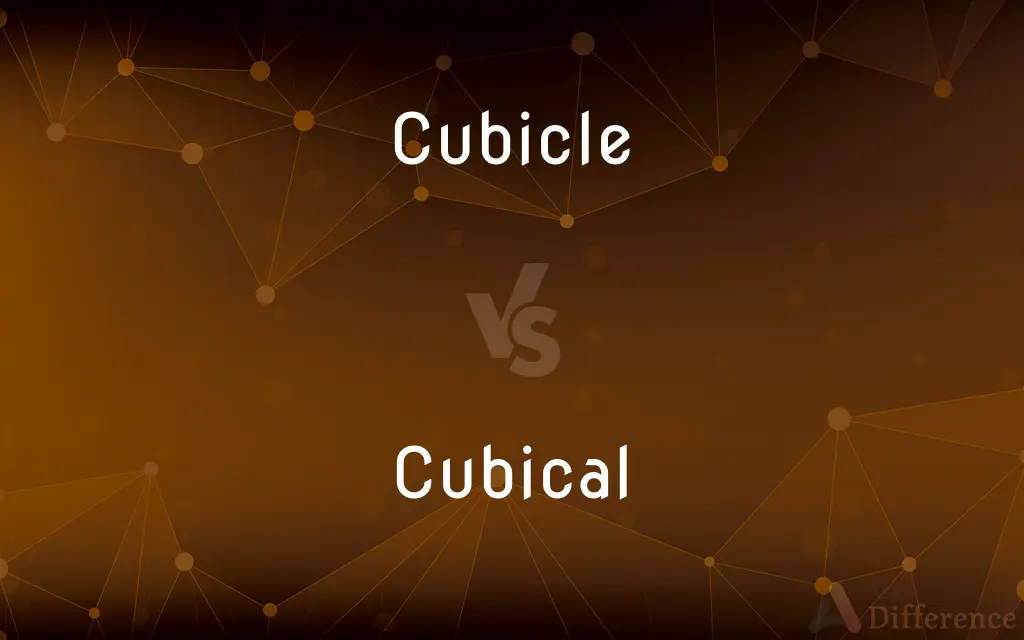Cubicle vs. Cubical — What's the Difference?
By Urooj Arif & Maham Liaqat — Updated on February 22, 2024
A cubicle is a partially enclosed office workspace, designed for a single occupant, while "cubical" is an adjective describing something that has the shape of a cube or is cube-like in nature.

Difference Between Cubicle and Cubical
Table of Contents
ADVERTISEMENT
Key Differences
Cubicles are a common feature in modern office environments, providing individual workspaces that offer a degree of privacy without the isolation of a full office. They are characterized by their partitioned walls, which separate workers, reducing noise and distractions while maximizing floor space. The term "cubicle" originally referred to sleeping quarters in monasteries or dormitories, but its meaning has since evolved to be synonymous with these semi-private office spaces.
On the other hand, "cubical" is not commonly used in everyday language but applies to objects or spaces that embody the geometric properties of a cube. For example, a cubical box has equal dimensions in height, width, and depth, forming a perfect cube. The term emphasizes the geometric aspect rather than any specific function or purpose.
The primary distinction between the two lies in their application: "cubicle" is used to describe a type of physical space within office settings, whereas "cubical" describes the shape or attributes of an object, not limited to any particular context. While a cubicle might be cubical in shape if it approximates a cube's dimensions, the terms serve different descriptive purposes.
In essence, when referring to office spaces, "cubicle" is the appropriate term. "Cubical" would be used in more technical or descriptive contexts, particularly when discussing geometry, shapes, or objects with cube-like dimensions. The understanding of these terms aids in clear communication, especially in professional or academic environments where precision is valued.
Comparison Chart
Definition
A partially enclosed office workspace for a single occupant.
Adjective describing something with the shape or properties of a cube.
ADVERTISEMENT
Usage
Refers to a type of space within office environments.
Describes the geometric attributes of objects or spaces.
Context
Modern office settings, work environments.
Geometry, descriptions of objects or spaces.
Application
Designed for individual workspaces, promoting privacy and efficiency.
Applied to objects or spaces that resemble or approximate a cube.
Form
Noun, denoting a specific type of physical space.
Adjective, describing the characteristics of something.
Compare with Definitions
Cubicle
Designed to maximize office space while providing some privacy.
The open-plan office was divided into cubicles to reduce noise.
Cubical
Describing an object that has the form of a cube.
The artist's installation featured several large cubical structures.
Cubicle
A small, partitioned-off area of an office for individual use.
She decorated her cubicle with photos and plants to make it feel more personal.
Cubical
Not commonly used in everyday language, more technical.
The architect described the new design as a series of interconnected cubical spaces.
Cubicle
Originates from Latin "cubiculum," meaning sleeping chamber.
Historical dormitories featured cubicles for individual privacy.
Cubical
Can be used in mathematical or geometric contexts.
The students were tasked with calculating the volume of cubical boxes.
Cubicle
Typically equipped with a desk, chair, and computer.
Each cubicle in the call center had its own headset and computer setup.
Cubical
Pertaining to something with equal dimensions on all sides.
The puzzle consisted of assembling small cubical pieces into a larger cube.
Cubicle
Can be arranged in various configurations to fit office layouts.
The office redesign included cubicles with lower walls to enhance collaboration.
Cubical
Sometimes used metaphorically to describe rigid or boxy thinking.
The critique urged him to move beyond cubical thinking in his approach.
Cubicle
A small enclosure at a swimming pool etc. used to provide personal privacy when changing.
Cubical
Of or relating to volume.
Cubicle
A loding room; esp., a sleeping place partitioned off from a large dormitory.
Cubical
Of or pertaining to a cube; cubic.
Cubicle
A small compartment, as for work or study.
Cubicle
A small separate part or one of the compartments of a room, especially in a work environment.
Most libraries provide cubicles for quiet study.
Common Curiosities
Is "cubical" a common term in office settings?
No, "cubical" is rarely used in office settings; "cubicle" is the standard term for describing individual workspaces.
Can "cubical" refer to anything other than geometry?
While primarily used in geometric contexts, "cubical" can be metaphorically applied to describe things that are boxy or limited in dimension.
Are all cubicles the same size?
No, the size and design of cubicles can vary widely depending on the office layout and the needs of the occupants.
Can cubicles be customized?
Yes, many cubicles allow for personalization and adjustments to suit the occupant's preferences and work requirements.
Do cubicles have doors?
Typically, cubicles do not have doors, relying instead on open entrances to balance privacy with accessibility.
Can a cubicle be cubical in shape?
Yes, if a cubicle's height, width, and depth are roughly equal, it could be described as cubical, though this is uncommon in office environments.
Do cubicles always have four walls?
Not necessarily; cubicles typically have three walls, with the open side serving as the entrance, though designs can vary.
Is "cubical" used in mathematics?
Yes, it's used in geometry to describe objects that have the shape of a cube, though the term is not exclusive to mathematics.
Are there alternatives to cubicles in office design?
Yes, alternatives include open desks, private offices, collaborative spaces, and flexible workstations.
How do cubicles promote productivity?
By providing a semi-private workspace that minimizes distractions while allowing for easy communication and collaboration when needed.
How has the design of cubicles evolved over time?
Cubicle designs have evolved to include more ergonomic features, lower walls for better collaboration, and modular components for flexibility.
Were cubicles originally designed for office use?
The modern office cubicle was designed in the 1960s to enhance flexibility and privacy in open-plan offices, but the term "cubicle" has older origins.
How does "cubical" relate to cubic equations?
"Cubical" relates to the shape or form, while cubic equations (in mathematics) involve variables raised to the third power, though both derive from the concept of a cube.
Is there a trend away from cubicles in modern offices?
Some modern offices favor open-plan layouts to encourage collaboration, though cubicles remain popular for their privacy and noise reduction benefits.
Can a room be described as "cubical"?
Yes, if a room has roughly equal dimensions in height, width, and depth, it could be described as "cubical."
Share Your Discovery

Previous Comparison
Theoretician vs. Theorist
Next Comparison
Homology vs. HomoplasyAuthor Spotlight
Written by
Urooj ArifUrooj is a skilled content writer at Ask Difference, known for her exceptional ability to simplify complex topics into engaging and informative content. With a passion for research and a flair for clear, concise writing, she consistently delivers articles that resonate with our diverse audience.
Co-written by
Maham Liaqat














































